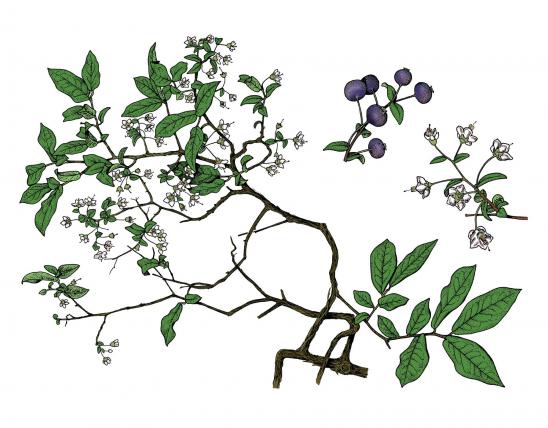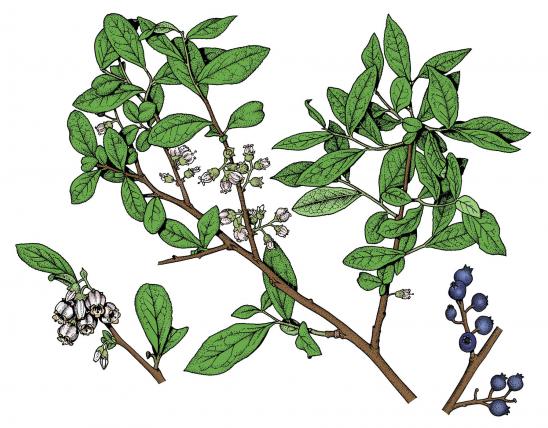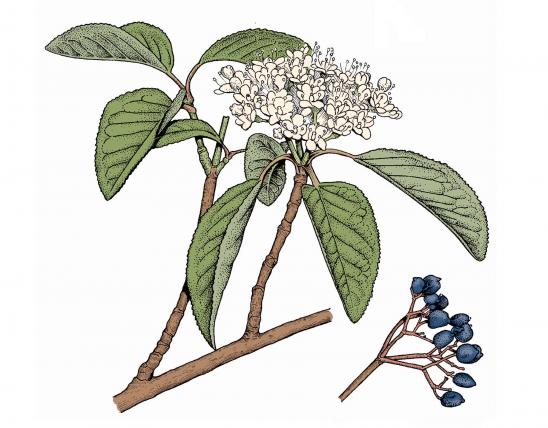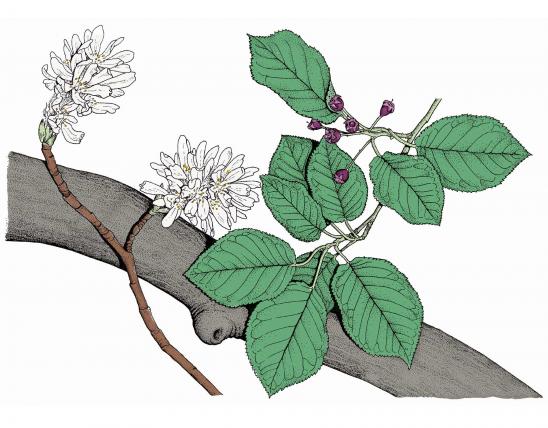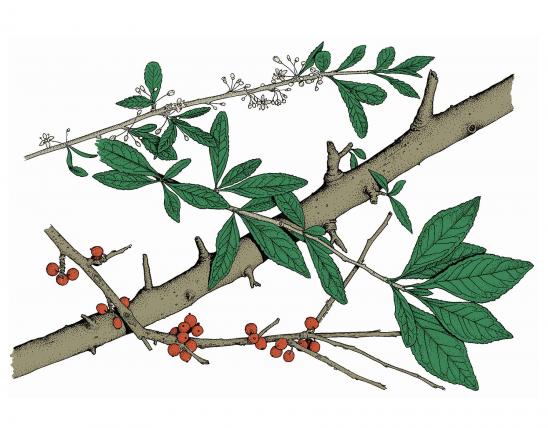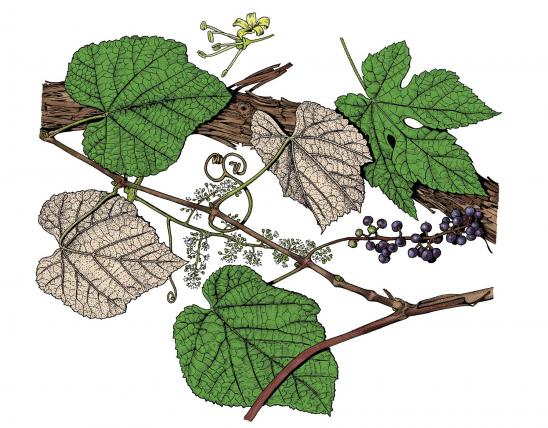
Farkleberry, also called sparkleberry, is a stiff-branched shrub or small crooked tree attaining a height of 20 feet. Some of the plants are tall, with rounded crowns, and others are somewhat flat-topped and have crooked, zigzag branches. Cut or burned stems will produce uncharacteristic straight shoots the first year with thinner, less glossy leaves.
Leaves are alternate, simple, sometimes evergreen, 1–3 inches long, about 1 inch wide, oval to broadest above the middle; the tip mostly rounded, or with a short, abrupt point; the base wedge-shaped; the margin entire or slightly toothed; leathery, glossy above; duller green and slightly hairy below; leaf stalk is almost absent, hairy.
Bark is dark brown or grayish brown, with fine grooves exposing the reddish inner bark; younger branches are reddish, with brown outer bark peeling off in flat, thin plates; the wood is hard, fine-grained, light reddish brown.
Twigs are slender, light brown to dark or reddish brown, spreading apart, smooth or hairy.
Flowers May–June, in loose clusters in the axils of leaves; flowers hanging, about ½ inch long, white or pinkish, bell-shaped, 5-lobed, curled at the tip; stamens 10, not extending beyond the flower. Flowers abundantly.
Fruits July–October, about ⅜ inch across, globe-shaped, black at maturity, shiny, persistent; the seeds are many, of various shapes, with flattened sides, golden brown, glossy, and deeply pitted. Fruits are edible and sweet but also rather dry and mealy-textured. The plant is rather sparsely fruited, with the fruits ripening throughout a long period.
Similar species: Four species of Vaccinium (blueberries) have been recorded as native or naturalized in Missouri. In addition to farkleberry, our other native blueberries are lowbush blueberry (V. pallidum) and deerberry (V. stamineum). The fourth, highbush or swamp blueberry (V. corymbosum), is apparently introduced; it’s uncommon in our state, known from a historical collection of a possibly native occurrence in Newton County, and a more recent, introduced occurrence in Ste. Genevieve County, where fruit plantings apparently escaped from cultivation. It’s an important fruit crop in the eastern and midwestern United States.
Another species, black huckleberry (Gaylussacia baccata), is in the same family as blueberries. Its leaves have numerous tiny, sticky, yellow resin dots (glands), at least on the undersurface, and its fruits (technically drupes, not berries) are leathery with 10 seedlike nutlets (whereas blueberries are berries with numerous seeds). It is critically imperiled in Missouri and known (for certain) only from a few sites in Montgomery and Perry counties.
Height: to 20 feet.
Scattered to common mostly south of the Missouri River, in the Mississippi lowlands of the Bootheel, Ozarks, Ozark Border, and extending into the Lincoln Hills portion of the Glaciated Plains (along the Mississippi River northwest of St. Louis).
Habitat and Conservation
Occurs in acid soils overlying sandstone, chert, or igneous bedrock. Habitats include rocky, open upland woods on dry slopes and ridges; margins of bluffs and glades; and occasionally low woods along creeks and near swamps. This species often forms loose thickets.
Status
Native shrub or small tree bearing edible but unpalatable fruits.
Human Connections
Fruits are edible, but their rather dry and mealy texture makes them less palatable than deerberry or lowbush blueberry. Tastiness varies by individual plant.
The leaves and the bark of the root have been used in a tea to treat sore throat and diarrhea. The fruit has been used to make a drink for treating chronic dysentery.
The dark green foliage, which is partially evergreen, together with the white flowers, give this shrub a very ornamental appearance. It does well in full sun, but like the azalea, it needs acidic soil.
Vaccinium is the blueberry genus, so farkleberry is closely related to the blueberries we know from jams, pies, muffins, and juices. In North America, several species of blueberries have been improved by plant breeders and are cultivated commercially, mostly in the northern and northeastern United States and Canada. These include the highbush blueberry (V. corymbosum), sweet lowbush blueberry (V. angustifolium), and cranberry (V. macrocarpon). Many other species of blueberry are harvested from the wild, including the lowbush or hillside blueberry (V. pallidum) in Missouri. Our other native species are generally considered less tasty, but individual plants may yield good fruit.
Expanding outward from genus, the blueberries belong to the heath or heather family (Ericaceae), a large and diverse family that includes many cultivated plants, including rhododendrons and azaleas, trailing arbutus, bearberry, mountain laurel, pieris/andromeda/fetterbush, and more. Most of these require acidic soils to do well, making them difficult to grow in many locations in our state, given the widespread calcareous soils in Missouri.
If you’ve been to the American west, you may have seen some of the many species of shrubby or ground-hugging manzanitas (Arctostaphylos spp.) or mountain heaths or heathers (Phyllodoce spp.). They’re in the same family. The downturned urn- or bell-shaped flowers are very distinctive in this family. Learning plant families usually involves recognizing similar flower and fruit forms.
Ecosystem Connections
Several kinds of birds eat the edible fruits, including northern bobwhite and American robin; other fruit-specialist birds include cedar waxwing, gray catbird, northern mockingbird, brown thrasher, orioles, blue jay, northern cardinal, eastern bluebird, chickadees, finches, grosbeaks, and tanagers.
Mammals that may eat the fruit include American black bear, chipmunks, mice, opossums, raccoons, and foxes. Deer and rabbits may browse the leaves and twigs.
The flowers of Vaccinium species are visited by large numbers of bees, mostly various types of bumblebees and andrenid bees, but also honeybees. Pollinators receive both nectar (from a disk inside the base of the bell-shaped fused petals) and pollen as their reward. Pollen accumulated in the long, narrow tubes falls out of the downward-facing flowers or is “buzzed” or vibrated out when they are disturbed by an insect visitor.
The flowers of Vaccinium species have characteristics that prevent them from self-fertilizing. For example, the flowers are usually protandrous; that is, the stamens (pollen-bearing structures) mature first, with the styles (pollen-receiving structures) maturing later. The stigmas become receptive to pollen only after the pollen of their own blossom has been dispersed.
A wide range of insects feed on various parts of Vaccinium species — beetles, flies, true bugs including aphids and other sucking insects, and grasshoppers. In many cases, the insect is specialized for eating only members of the Vaccinium genus and their close relatives, and nothing else.
Several species of butterflies and moths use Vaccinium species as their larval host plants. Examples are Henry’s elfin, spring azure, Harris’s three-spot, decorated owlet, azalea sphinx, pawpaw sphinx, huckleberry sphinx, apple sphinx, and yellow-washed metarranthis. As with other insects, some of these must use only blueberries and their close relatives as their food plants, while others are polyphagous (able to eat a wider variety of plants).
























